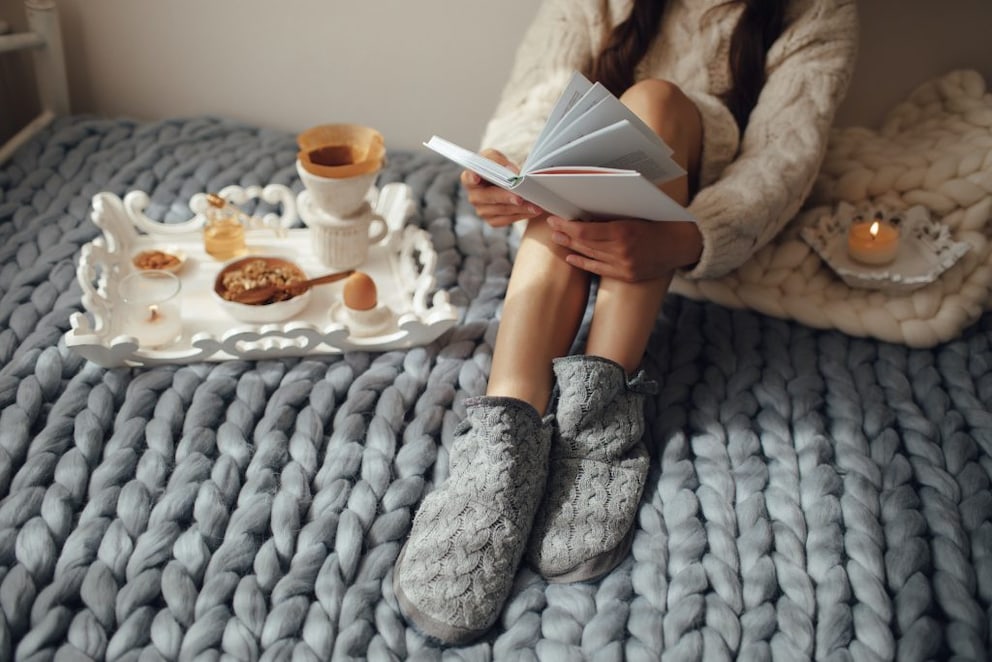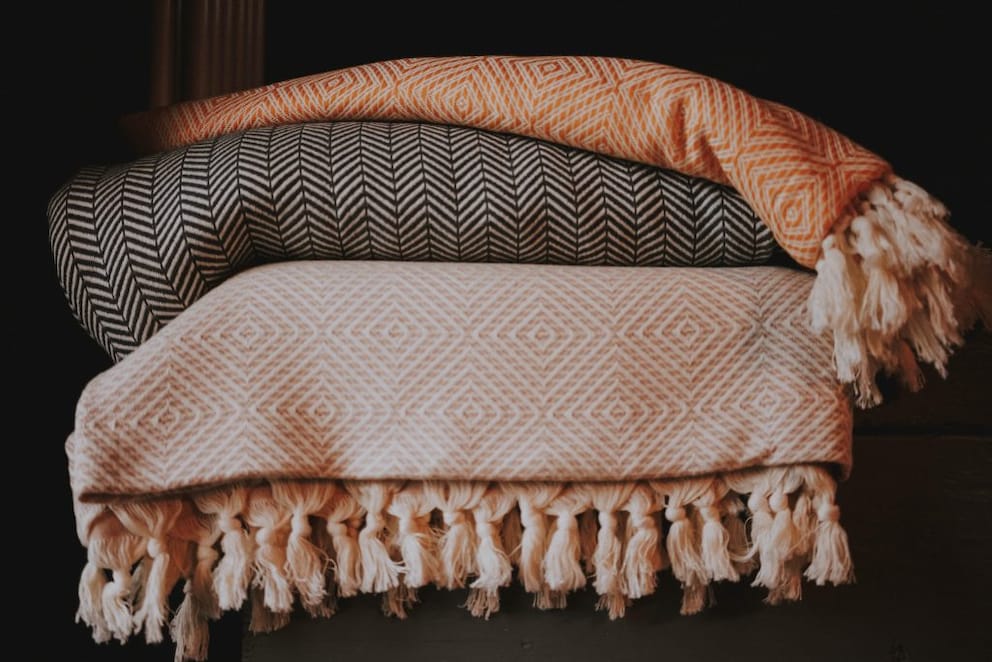November 22, 2021, 4:20 pm | Read time: 5 minutes
Mohair, alpaca, and cashmere are primarily known in the fashion world, but they also serve a purpose in interior design. Discover where these different types of wool come from, their distinctions, and why they are ideal as home textiles for winter.
The cold, uncomfortable days have arrived, and the heating is already warming up. To increase the level of coziness, wool home textiles are ideal for getting through the winter. While they can be quite pricey, they meet all the demands one has for pillows, blankets, and the like during the cold season. What you need to know about all wool home textiles for winter, what they are suitable for, and the differences between them are revealed in the following brief material guide.
Table of Contents
Angora Wool
The fluffy Angora wool comes from the Angora rabbit and is always labeled as “Angora.” This is important to know because there is also the Angora goat in nature. However, its wool is highly curled and must be labeled as “Angora goat” in the product description of a home textile.
To obtain Angora wool, the animal is sheared or combed. However, most wool comes from Asian fur farms, which are notoriously questionable regarding animal welfare. If a home textile made of Angora wool is conspicuously cheap, it is almost certainly such a product.
Typically, Angora wool is considered to be in the high-price segment. No more than 250 grams of wool is obtained annually from a single rabbit. The fine fur hair is said to have healing properties, especially to alleviate rheumatic complaints. The warming Angora wool is often processed into blankets as home textiles–however, this type of wool tends to felt quickly.
Merino Wool
This type of wool comes from the Merino sheep, whose wool fibers are extremely fine and thin, but above all, only half as thick as the fibers of regular sheep’s wool. The delicate texture of the fibers also ensures that Merino wool, for example, does not scratch unpleasantly when used as a blanket. This is particularly practical when the soft, warming quality of this home textile is used as a baby blanket in winter.

This noble type of wool is considered easy to care for in many respects, as the special fiber structure provides a self-cleaning property. The wool hardly attracts dirt particles, is odor-neutralizing, and moisture-regulating. Therefore, it rarely needs washing. And if cleaning is necessary, it takes little time, as Merino wool dries quickly.
Also interesting: 7 stylish bedspreads
Mohair
Beware of confusion: Mohair is the wool of the Angora goat, not the Angora wool from the Angora rabbit. Mohair wool is predominantly obtained in South Africa and the USA (Texas), as the climatic conditions in these parts of the world are ideal for breeding the Angora goat.
A favorable place of origin also affects the quality of the wool. The long-fibered, curly hair has a slight sheen and is also silky soft. The warming Mohair wool is often further processed into knitted blankets for winter or cushion covers in the home textiles sector. Although this type of wool is considered durable, it is not exactly easy to care for, as Mohair wool can only be washed cold. Felting is rare in home textiles made from Mohair.
Also interesting: 7 tips to improve indoor air
Cashmere
Cashmere is obtained from the goat of the same name, which in turn owes its name to its origin in the Himalayas. The animals with the valuable undercoat are also bred in Mongolia, Iran, and China. This is still obtained by hand combing and amounts to a maximum yield of 150 grams per animal per year, which is why the fine luxury wool is also expensive. Shearing would only cause sensitive damage to the fine wool fibers.

Also interesting: Tips to help with shedding wool blankets
In general, Cashmere is considered sensitive, as it is not particularly durable and stretches quickly. When washing, it should not be rubbed, or it will felt quickly. When used as a home textile in winter, in the form of cushion covers, cozy blankets, or mattress covers, many positive properties of Cashmere wool come into play. The natural fiber is not only exceptionally light and soft, but it also has a natural sheen and is considered tear-resistant. Its pronounced resistance to dirt, odor, and moisture also increases the demand for Cashmere.

7 Sustainable Bedding Fillings for a Healthy Sleep

The 7 Most Beautiful Throw Blankets for Your Sofa

Synthetic, Down, Natural Hair – Finding the Right Comforter
Alpaca Wool
Alpaca wool has been gaining popularity for some time. Not without reason, as this type of wool is considered one of the warmest in the world. This is because Alpaca wool has a heat-insulating function. Small air pockets ensure that Alpaca wool retains heat better than other types of wool.
Originally, Alpaca wool comes from South American Peru, but Alpacas are now also bred in Europe and Germany. The still limited production here is one reason why the fine luxury yarn still has a relatively high market price. Its comparatively low weight makes Alpaca wool particularly interesting for DIY projects like knitting and crocheting. Since this type of wool is free of wool fat, it is suitable for allergy sufferers. Furthermore, Alpaca wool is considered odor-neutralizing, dirt- and moisture-repellent, so it generally does not require further cleaning–regular airing is sufficient. Additionally, the natural fiber does not scratch and hardly felts.

